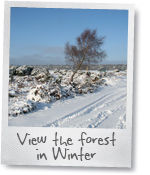|
The landscape is unique and traditions exist here that are unchanged since mediaeval times. Over the centuries too many places have changed almost beyond recognition yet the New Forest’s ancient woodlands and wilderness heath remains largely intact, earning the area national and international status.
This most English of forests continues to be a living and working community where ponies and cattle still have right of way as they freely graze the land. Deeper in the forest wild deer browse beneath canopies of mighty oak and beech – natural scenes unchanged by the modern world.
It is remarkable that this way of life has survived as a remnant of ancient England along with the unmistakable landscape it created, when so much of our heritage has been lost elsewhere.
The New Forest was created by King William I in 1079, just 13 years after the Battle of Hastings. This was the land of earlier Jutish settlers known as Ytene. For William, it was ideal for a new hunting ground, a poor, thinly populated district of furzey waste and ancient woodland covering over 200 square miles, yet close to his royal capital of Winchester.
In Norman times, the word ‘forest’ had dark overtones, signifying a land ruled without quarter by kings who jealously guarded their right to hunt unhindered by the petty concerns of local people. To these poor folk, the forest law was brutal. They could not protect their crops with fences or hedges. They could not take timber for their houses. They could not catch game for their pots. The penalty was mutilation or death. But it was grudgingly conceded that they had to live on something, and to this end they were allowed to graze livestock on the forest wastes. This right survives 900 years later as animals owned by local people still roam across the forest.
Their grazing has created and maintained the landscape that is such a well-loved part of our national heritage. Without constant browsing, the forest would soon disappear under heavy scrub and the wide open spaces would be no more. The New Forest with its wonderfully rich collection of plants, birds and insects is now a national nature reserve. It is unique in this country for its sense of freedom. With the exception of the timber inclosures, no boundaries separate one habitat from another. Wild antiquity has determined this rich mosaic of ancient woodlands, windswept heaths, wet valley mires and fertile streamside lawns.
An intriguing paradox, this ancient forest, now managed by the Forestry Commission, changes but little each century yet is always on the move, forever advancing and decaying through a timeless ebb and flow of nature. As we enter the New Forest today, we appear to step backwards
in time. The landscape is unique and traditions exist here
that are unchanged since mediaeval times. The New Forest’s
ancient woodlands and wilderness heaths remain largely intact,
earning the area national and international status.
|




